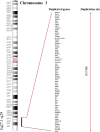New insights on partial trisomy 3q syndrome: de novo 3q27.1-q29 duplication in a newborn with pre and postnatal overgrowth and assisted reproductive conception
- PMID: 36759911
- PMCID: PMC9909891
- DOI: 10.1186/s13052-023-01421-y
New insights on partial trisomy 3q syndrome: de novo 3q27.1-q29 duplication in a newborn with pre and postnatal overgrowth and assisted reproductive conception
Abstract
Background: Duplications of the long arm of chromosome 3 are rare, and associated to a well-defined contiguous gene syndrome known as partial trisomy 3q syndrome. It has been first described in 1966 by Falek et al., and since then around 100 patients have been reported. Clinical manifestations include characteristic facial dysmorphic features, microcephaly, hirsutism, congenital heart disease, genitourinary anomalies, hand and feet abnormalities, growth disturbances and intellectual disability. Most of cases are due to unbalanced translocations, inherited from a parent carrying a balanced aberration (reciprocal translocation or inversion), and rarely the genomic anomaly arises de novo. Very few studies report on the prenatal identification of such rearrangements.
Case presentation: Hereby, we report on a newborn with a rare pure duplication of the long arm of chromosome 3. Noninvasive prenatal test (cell free fetal DNA analysis on maternal blood), performed for advanced parental age and use of assisted reproductive technique, evidenced a partial 3q trisomy. Then, invasive cytogenetic (standard and molecular) investigations, carried out through amniocentesis, confirmed and defined a 3q27.1-q29 duplication spanning 10.9 Mb, and including about 80 genes. Our patient showed clinical findings (typical facial dysmorphic features, esotropia, short neck, atrial septal defect, hepatomegaly, mild motor delay) compatible with partial trisomy 3q syndrome diagnosis, in addition to pre- and postnatal overgrowth.
Conclusions: Advanced parental age increases the probability of chromosomal and/or genomic anomalies, while ART that of epigenomic defects. Both conditions, thus, deserve more careful prenatal monitoring and screening/diagnostic investigations. Among the latter, cell free fetal DNA testing can detect large segmental aneuploidies, along with chromosomal abnormalities. It identified in our patient a wide 3q rearrangement, then confirmed and defined through invasive molecular cytogenetic analysis. Neonatologists and pediatricians must be aware of the potential risks associated to duplication syndromes. Therefore, they should offer to affected subjects an adequate management and early and careful follow-up. These may be able to guarantee to patients satisfactory growth and development profiles, prevent and/or limit neurodevelopmental disorders, and timely recognition of complications.
Keywords: ART; Case report; Chromosome 3; Contiguous gene syndrome; Prenatal diagnosis; a-CGH.
© 2023. The Author(s).
Conflict of interest statement
The authors declare that they have no competing interests.
Figures



Similar articles
-
"Essentially" pure trisomy 3q27 --> qter: further delineation of the partial trisomy 3q phenotype.Am J Med Genet A. 2009 Nov;149A(11):2522-6. doi: 10.1002/ajmg.a.33058. Am J Med Genet A. 2009. PMID: 19842202
-
Recurrent fetal syndromic spina bifida associated with 3q26.1-qter duplication and 5p13.33-pter deletion due to familial balanced rearrangement.Taiwan J Obstet Gynecol. 2016 Jun;55(3):410-4. doi: 10.1016/j.tjog.2016.04.018. Taiwan J Obstet Gynecol. 2016. PMID: 27343325
-
Inherited unbalanced reciprocal translocation with 3q duplication and 5p deletion in a foetus revealed by cell-free foetal DNA (cffDNA) testing: a case report.Eur J Med Res. 2021 Jun 29;26(1):64. doi: 10.1186/s40001-021-00535-5. Eur J Med Res. 2021. PMID: 34187576 Free PMC article.
-
Chromosomal-array analysis reveals partial 11q duplication and partial 12p deletion in a mildly affected case.Am J Med Genet A. 2014 Jul;164A(7):1770-6. doi: 10.1002/ajmg.a.36495. Epub 2014 Mar 26. Am J Med Genet A. 2014. PMID: 24677787 Review.
-
A pure de novo 16p13.3 duplication and amplification in a patient with femoral hypoplasia, psychomotor retardation, heart defect, and facial dysmorphism-a case report and literature review of the partial 16p13.3 trisomy syndrome.J Appl Genet. 2023 Feb;64(1):125-134. doi: 10.1007/s13353-022-00743-7. Epub 2022 Dec 31. J Appl Genet. 2023. PMID: 36586055 Free PMC article. Review.
Cited by
-
Concurrent de novo MACF1 mutation and inherited 16p13.11 microduplication in a preterm newborn with hypotonia, joint hyperlaxity and multiple congenital malformations: a case report.BMC Pediatr. 2024 Aug 16;24(1):528. doi: 10.1186/s12887-024-04628-y. BMC Pediatr. 2024. PMID: 39152427 Free PMC article.
-
Advances in pediatrics in 2023: choices in allergy, analgesia, cardiology, endocrinology, gastroenterology, genetics, global health, hematology, infectious diseases, neonatology, neurology, pulmonology.Ital J Pediatr. 2024 Nov 14;50(1):244. doi: 10.1186/s13052-024-01818-3. Ital J Pediatr. 2024. PMID: 39538247 Free PMC article. Review.
-
Carnitine palmitoyltransferase II (CPT II) deficiency responsible for refractory cardiac arrhythmias, acute multiorgan failure and early fatal outcome.Ital J Pediatr. 2024 Apr 14;50(1):67. doi: 10.1186/s13052-024-01632-x. Ital J Pediatr. 2024. PMID: 38616285 Free PMC article.
-
Increased PLAGL1 Gene Methylation in Cord Blood is Positively Correlated with Brain Injury in Chorioamniotic Preterm Infants.Biochem Genet. 2025 Apr;63(2):1361-1380. doi: 10.1007/s10528-024-10762-0. Epub 2024 Apr 2. Biochem Genet. 2025. PMID: 38564096
References
-
- Grossmann V, Müller D, Müller W, Fresser F, Erdel M, Janecke AR, Zschocke J, Utermann G, Kotzot D. "Essentially" pure trisomy 3q27 –> qter: further delineation of the partial trisomy 3q phenotype. Am J Med Genet A. 2009;149A(11):2522–2526. - PubMed
-
- Falek A, Schmidt R, Jervis GA. Familial de Lange syndrome with chromosome abnormalities. Pediatrics. 1966;37(1):92–101. - PubMed
-
- Dworschak GC, Crétolle C, Hilger A, Engels H, Korsch E, Reutter H, Ludwig M. Comprehensive review of the duplication 3q syndrome and report of a patient with Currarino syndrome and de novo duplication 3q26.32-q27.2. Clin Genet. 2017;91(5):661–671. - PubMed
Publication types
MeSH terms
Substances
Supplementary concepts
LinkOut - more resources
Full Text Sources
Miscellaneous

